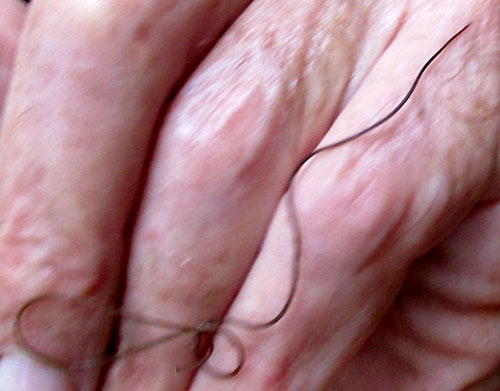Excerpts from Jim Conrad's
Naturalist Newsletter
entry from field notes dated October 7, 2022, taken about 3kms north of Gómez Farías, in woodland along the road approaching the bottom of Cañón el Azteca, Aztec Canyon, on the lower eastern slope of the Eastern Sierra Madres, El Cielo Biosphere Reserve, southern Tamaulipas state, MÉXICO; elevation about 300m (1000 ft), ± LAT. 23.04°N, LONG. 99.15°W
HORSEHAIR WORM

In El Cielo Biosphere Reserve I'd planned to wander far, drinking from the numerous streams that during my previous visits had been gushing with water. But this year the area was suffering from a hard drought, and all streambeds were dry.
Still, finally toward the bottom of Cañón el Azteca, a dry stream turned up half blocked by a huge bolder, and on the bolder's lower side where water, when it rains, swirls around scouring away sand and gravel at the whirlpool's bottom, there was a little puddle about the size of a saucer with maybe 2cm (less than an inch) of water in it. Beneath the bounder's overhang, a Giant Toad watched me insert the end of a plastic tube into the water and start pumping water through a ceramic filter, into a water bottle.
The moment the puddle's water level began dropping, the amazingly slender worm shown atop this page shot from among tree leaves lining the puddle. The worm was maybe 9cm long (3½ inches); In the above picture, the knuckle of my small finger on the picture's right side is 17mm across. The creature's movements, instead of being sinuous like an earthworm's, were oddly stiff and seemed somewhat erratic. A second identical worm emerged from the same leaves, entangling with the first one.
I wondered about the worms' strong reaction to the puddle's lowering water level. Expecting the puddle quickly to be refilled, it seemed the worms revealed their presence to possible predators for no good reason. However, once I'd filtered about a liter of water, I began understanding. The pool didn't refill. The next day when I checked, it was completely dry. Losing that water was perhaps a critical loss to the worms, and maybe the Giant Toad, too, and I regretted taking their water, despite needing it myself.
I'd seen such worms before, always associated with standing water, so I knew they were known as horsehair worms. That name doesn't apply to just a single species, but rather to a whole phylum of worms. Phyla are very big subdivisions. All arthropods such as insects, lobsters and scorpions constitute a phylum. It's the same with mollusks from clams to snails, and of course there's the chordate phylum embracing animals with backbones, from fish and birds to us mammalian humans. Horsehair worms being assigned to their own Horsehair Worm phylum, the Nematomorpha -- probably comprising over 2000 species -- indicates that in very fundamental ways they're unlike all other living things.
For one thing, they have no respiratory, circulatory or excretory systems -- no lungs, no blood-circulating, and no pooping. Being so long and slender, no part of the body's interior is far from the skin, through which oxygen and nutrients can be absorbed directly, so lungs, heart and the rest aren't needed. Horsehair worms do have guts, but they're non-functional. The worms have only longitudinal muscles, which may explain the jerky lack of sinuosity observed at the puddle.
One of the most interesting features about horsehair worms is that their larval stage is parasitic on arthropods and crustaceans. There seems to be some debate about whether they parasitize humans. They have been found inside humans and in our excreta, but may have gotten there by being eaten or drunk, or when the person was swimming. If you want to view creepy videos of horsehair worm larvae emerging from their unfortunate hosts, do an Internet search on the keywords "youtube horsehair worm larvae emerging." Some species can influence their host's behavior.
In general, horsehair worms are aquatic or semi-aquatic, and occur worldwide in freshwater or marine environments.
When I do an image search on the phylum Nematomorpha of Mexico, pictures turn up showing pale colored horsehair worms and black ones like ours. Pictures of black ones of the size as ours and in aquatic environments are labeled as the genus Gordius, with no efforts made to identify to species. The larvae of Gordius species mostly parasitize beetles, but also various kinds of mantids and other insects. Around 80 Gordius species are recognized, and the best bet is that our picture shows a Gordius.